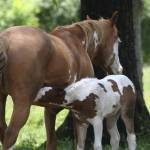Embryo Transfer, Placental Alterations, and the Developing Foal

With the widespread adoption of assisted reproductive technologies, horse owners have the freedom to essentially inseminate any embryo into any mare at almost any point in time. In cases of embryo transfer, for example, recipient mares are frequently selected based on the character or availability of the mare rather than her suitability as an optimal surrogate.
Previous research shows that transferring embryos between pony breeds and larger breeds, such as drafts, Thoroughbreds, or Saddlebreds, can impact the size and metabolism of the foal. Whether or not the foal was adversely affected depended on whether the embryo was placed in a growth-enhanced (i.e., a pony breed in a larger recipient mare) or a growth-restricted (i.e., a larger breed in a pony recipient mare) environment.
“We know that the placenta does more than simply nourish the developing foal. The placenta also transmits stimuli from the maternal environment to the fetus. Those stimuli result in placental adaptations in terms of function, size, and shape,” explained Laura Petroski, B.V.M.S., veterinarian for Kentucky Equine Research (KER).
She added, “The genetic makeup of the recipient mare can also influence the genetics of the foal—a process now referred to as epigenetics.”
Despite realizing that the foal’s environment, be it richer or poorer, impacts growth and lifetime development, researchers still have much to learn about the exact changes that occur in different mare and foal combinations.
Recently, a group of European researchers took the next step in this research, transferring embryos between pony, Saddlebred, and draft mares. Their research confirmed that:
- Foals transferred from Saddlebred to pony mares were growth retarded and had an increased gestational length;
- Placental weight was reduced in these growth-restricted pregnancies but the surface density and volume were increased; and
- Genes involved in growth, development, and the transfer of nutrients between the placenta and foal were also strongly reduced.
Interestingly, changes in gene expression in the placentas of draft recipient mares carrying pony and Saddlebred foals (i.e., a growth-enhanced environment) were not markedly altered.
“Further research in this field is important considering that approximately 22,000 equine embryos are transferred worldwide each year. Having a better understanding of the dynamic relationship between the recipient mare and the embryo can optimize the health of the developing foal and minimize the occurrence of potentially avoidable diseases in the future, including insulin resistance, obesity, metabolic syndrome, and laminitis,” Petroski emphasized.
In the meantime, optimizing mare nutrition for appropriate fetal growth will also benefit the long-term health of both mare and foal. Consult with a KER nutrition advisor today to learn how.
*Robles, M., P.M. Peugnet, S.A. Valentino, et al. Placental alterations in structure and function in intra-uterine growth-retarded horses. Equine Veterinary Journal. In press.








